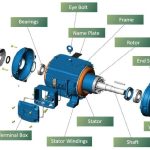
Introduction to Electric Motor Journal Ends
The journal end is a crucial component of electric motors, simply put, it’s the cylindrical area where the motor shaft contacts the bearing. It acts as a “supporting pillar” during motor operation, helping the motor shaft rotate smoothly. To ensure proper functioning of the journal end, several key aspects must be considered during manufacturing:
The surface must be extremely smooth, like a mirror
High-quality steel materials must be used, such as AISI 4140 and 4340 special steels
Dimensions must be very precise, with tolerances less than one-fifth of a human hair
Oil grooves are incorporated into the design to help better distribute lubricant
Working Characteristics
The journal end performs these main functions:
Supporting motor shaft rotation
Maintaining shaft alignment
Reducing friction
Bearing loads from all directions
To ensure normal operation of the journal end, attention must be paid to:
Maintaining proper oil film thickness
Monitoring temperature and speed
Preventing dust and moisture intrusion
Ensuring proper fit between bearing and journal end
Maintenance and Care
To ensure long-term reliable operation of journal ends, the following maintenance work is necessary:
Regular inspection for surface damage
Monitoring lubricant condition
Checking alignment
Watching for abnormal vibrations
When problems are discovered, prompt action is needed:
Identify the root cause
Take appropriate corrective measures
Document maintenance activities
Prevent similar problems from recurring
Technological Progress and Future Development
Journal end technology continues to advance:
Using new materials with better wear resistance
Incorporating smart sensors for real-time monitoring
Adopting advanced manufacturing technologies like 3D printing
Developing new lubrication systems
Future developments may include:
Self-healing materials
Smarter monitoring systems
More environmentally friendly designs
Lower-cost manufacturing methods
These developments will help motors perform better across various industries.








